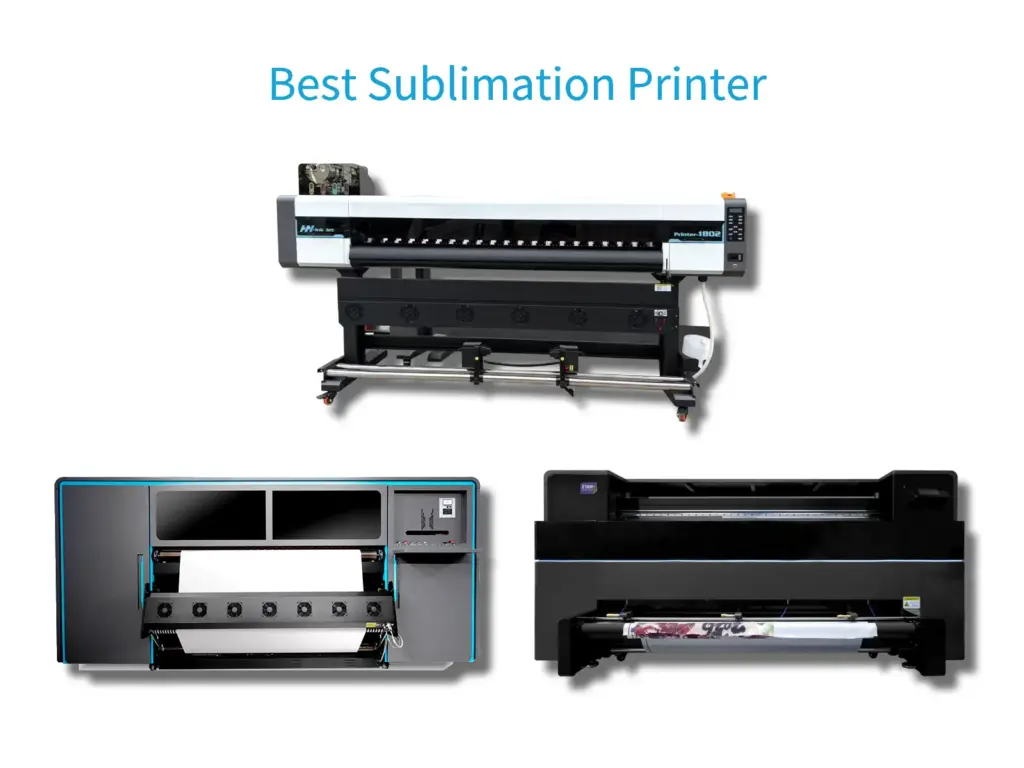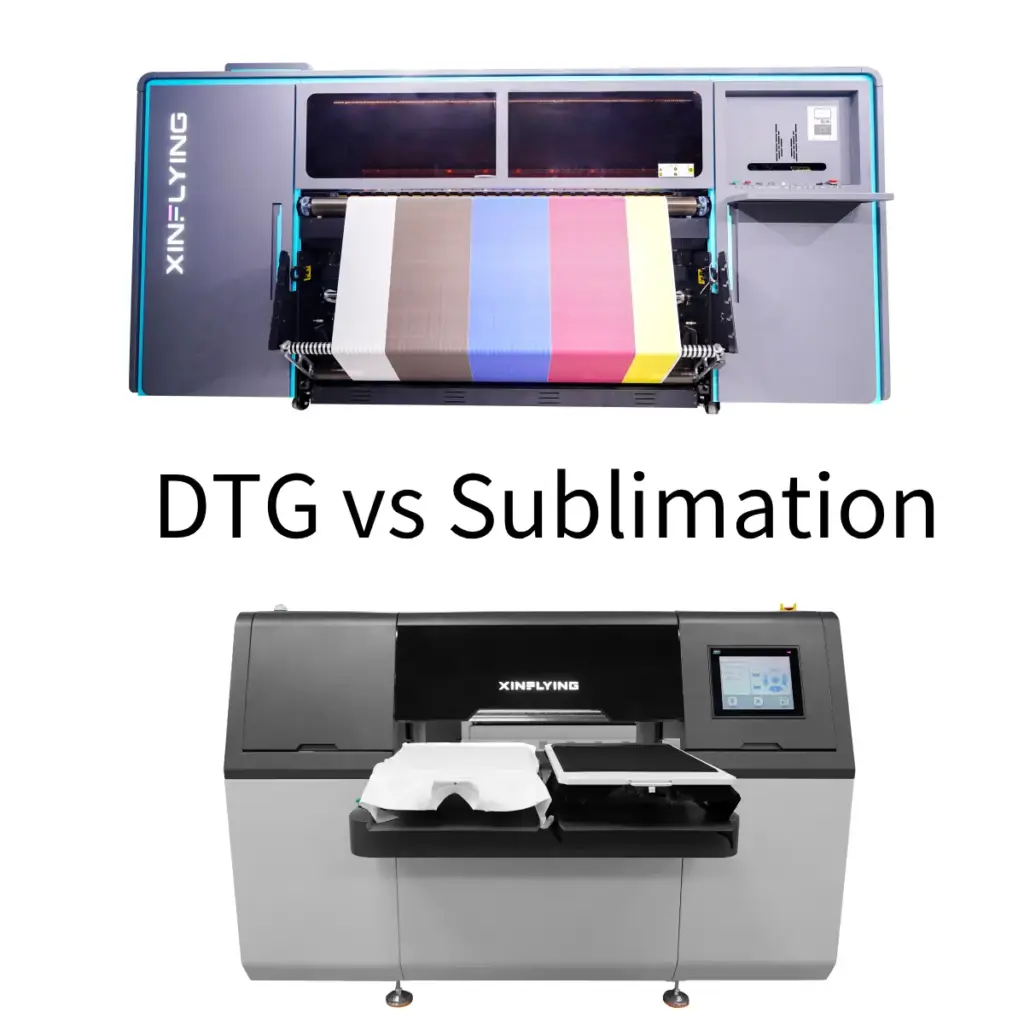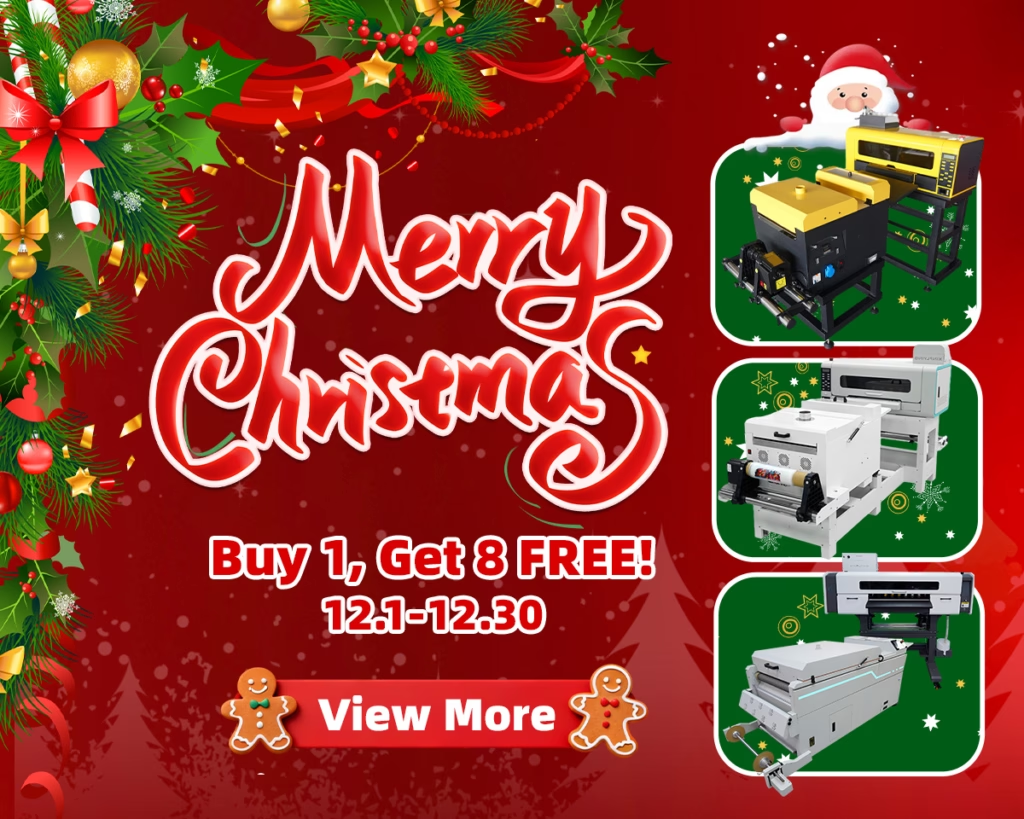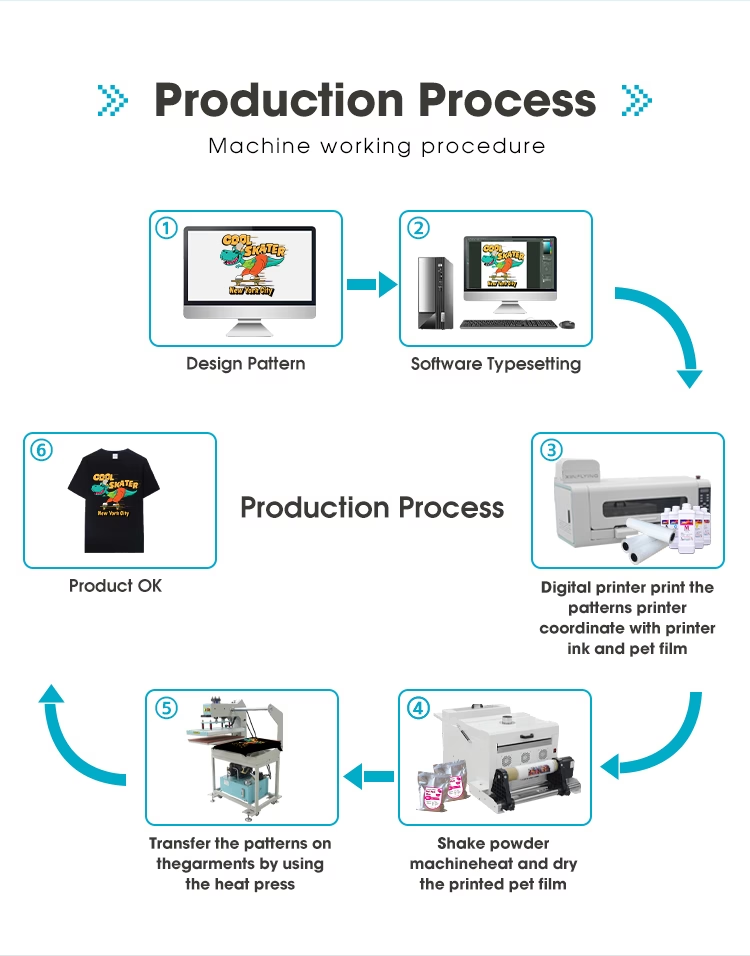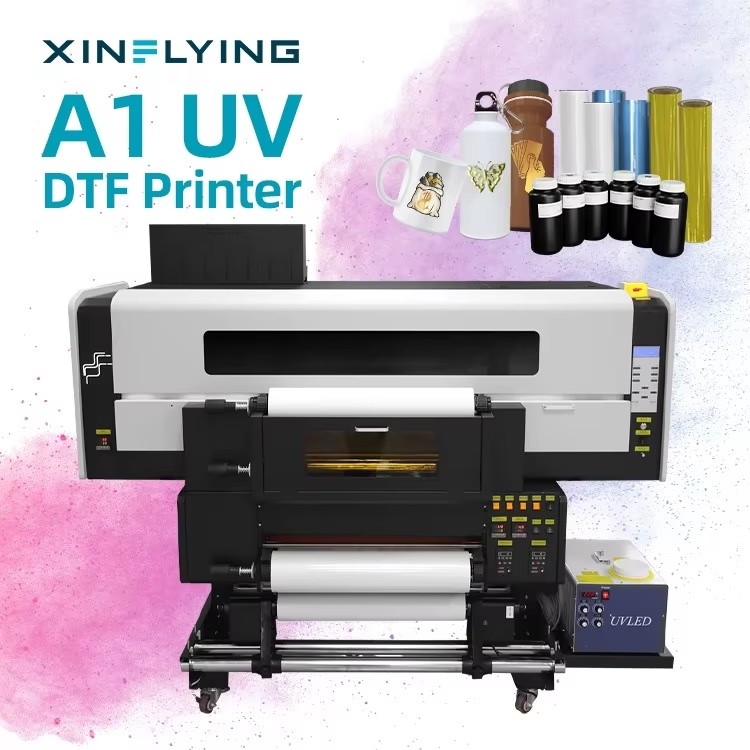Die Drucktechnologie hat einen langen Weg zurückgelegt, bietet verschiedene Methoden, um Bilder auf verschiedenen Oberflächen zum Leben zu erwecken. Zwei beliebte Drucktechniken in der Branche sind heute der UV-DTF-Druck und der DTF-Druck. Beide Methoden liefern beeindruckende Ergebnisse, Sie haben besondere Merkmale, die sie auszeichnen. In diesem Artikel, Wir werden uns mit den Details jeder Druckmethode befassen, Vergleichen Sie ihre Stärken und Grenzen, und geben Ihnen Hinweise zur Auswahl der richtigen Druckmethode für Ihre Anforderungen.
Was ist UV-DTF-Druck??
UV-DTF-Druck, Abkürzung für Ultraviolet Direct to Film Printing, ist eine Spitzentechnologie, die hochwertige Bildübertragungen auf verschiedene Substrate ermöglicht. Im Gegensatz zu herkömmlichen Druckmethoden, UV-DTF-Druck nutzt Ultraviolett (UV) Mit UV-Licht ausgehärtete Tinten für außergewöhnliche Haltbarkeit und lebendige Farben.
So verwenden Sie den UV-DTF-Drucker?
Schritt 1: Design mit der RIP-Software
zuerst, Bereiten Sie das Bildmaterial mit der RIP-Software auf dem Computer vor. Anschließend legen Sie die UV-DTF-A-Folie auf die Plattform des UV-DTF-Druckers.
Schritt 2: Drucken Sie auf einen Film
Füllen Sie die Patrone vorab mit CMYK-Tinte, weiße Tinte, und Lack zum Drucken Ihres Designs auf dem UV DTF A -Film.
Schritt 3: Laminierte B-Folie
Legen Sie die bedruckte A-Folie in die Laminiermaschine, um sie mit der B-Folie zu verkleben.
Schritt 4: Legen Sie die Folie auf die Produkte
Ziehen Sie den Film des Musters ab und kleben Sie es auf den Artikel, den Sie drucken möchten. Dann schälen Sie dann langsam den B -Film, und Ihr Produkt ist fertig.
Vor- und Nachteile des UV -DTF -Drucks

Vorteile des UV-DTF-Drucks
- Hohe Bildqualität und Schärfe
Der UV-DTF-Druck bietet eine außergewöhnliche Bildqualität mit scharfen Details und lebendigen Farben. Die UV-Tinten verfügen über eine große Farbskala, Genaue Farbwiedergabe ermöglichen.
- Große Farbskala
Der UV-DTF-Druck ermöglicht den Druck einer breiten Farbpalette auf verschiedenen Substraten, Das Ergebnis sind reichhaltige und lebendige Designs.
- Schnelle Produktionszeit
Im Vergleich zu herkömmlichen Druckmethoden, Der UV-DTF-Druck bietet schnellere Produktionszeiten. Die UV-Tinten trocknen nahezu sofort, Dadurch entfallen längere Trocknungszeiten.
- Möglichkeit zum Drucken auf verschiedenen Substraten
Der UV-DTF-Druck bietet die Flexibilität, auf einer Vielzahl von Materialien zu drucken, einschließlich Stoffe, Kunststoffe, Glas, und mehr. Diese Vielseitigkeit macht es zur idealen Wahl für Unternehmen, die ihr Produktangebot diversifizieren möchten.
Einschränkungen des UV-DTF-Drucks
- Kosten für UV-Tinten und -Ausrüstung
Für den UV-DTF-Druck sind spezielle UV-Tinten und -Geräte erforderlich, Dies kann im Vergleich zu herkömmlichen Druckmaterialien teurer sein. Zusätzlich, UV-Tinten können eine kürzere Haltbarkeit haben, erfordern häufigen Austausch.
- Begrenzte Flexibilität bei bestimmten Materialien
Während der UV-DTF-Druck auf verschiedene Substrate angewendet werden kann, Einige Materialien sind aufgrund ihrer Textur oder Oberflächenbeschaffenheit möglicherweise nicht geeignet. Es ist wichtig, den Druck auf verschiedenen Materialien zu testen, bevor Sie sich für eine Großserienproduktion entscheiden.
- Wartungs- und Instandhaltungsanforderungen
UV-DTF-Druckgeräte erfordern regelmäßige Wartung und Instandhaltung, um eine gleichbleibende Leistung sicherzustellen. Dazu gehört die Reinigung der Druckköpfe und die Gewährleistung optimaler Bedingungen für die UV-Härtung.
Was ist DTF-Druck??
DTF-Druck, oder Direkt zum Filmdruck, ist eine Technik, bei der Designs mit Spezialtinten auf eine Folie gedruckt werden, die später auf das gewünschte Substrat übertragen werden.
So verwenden Sie den DTF-Drucker?
Schritt 1: Design mit der RIP-Software
Ähnlich dem UV-DTF-Druck, Entwerfen Sie das Kunstwerk mit einer Grafikdesign-Software, um sicherzustellen, dass das gewünschte Design und die gewünschte Bildqualität erreicht werden.
Schritt 2: Drucken Sie auf die PET-Folie
Legen Sie die PET-Folie in das ein DTF-Drucker Legen Sie die Fächer ein und beginnen Sie mit dem Drucken. Anschließend wird das Designmuster darauf übertragen.
Schritt 3: Bond-Tinte mit Pulver
Mit einer Pulverschüttelmaschine, Die DTF-Klebepulver kann sich gleichmäßig auf der PET-Folie verteilen und die Grafiken trocknen.
Schritt 4: Transfermuster auf Textil
Legen Sie die DTF-PET-Folie auf das Substrat und übertragen Sie das Design mit einer Heißpressmaschine.
Vor- und Nachteile des DTF-Drucks
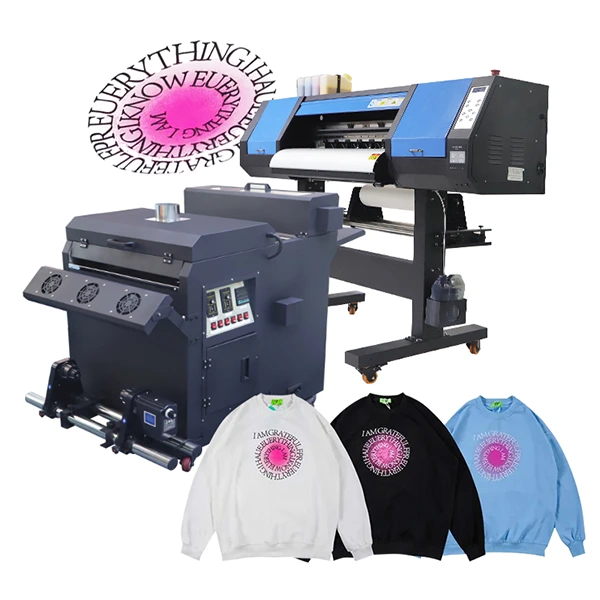
Vorteile des DTF-Drucks
- Kostengünstige Druckmethode
Der DTF-Druck gilt als kostengünstig, Dies ist vor allem auf die geringeren Geräte- und Tintenkosten im Vergleich zum UV-DTF-Druck zurückzuführen. Dies macht es für kleine Unternehmen und Einzelpersonen zugänglich, die in die Druckindustrie einsteigen möchten.
- Vielseitigkeit hinsichtlich kompatibler Untergründe
Wie UV-DTF-Druck, Der DTF-Druck ermöglicht das Drucken auf verschiedenen Substraten, einschließlich Stoffe, Keramik, Kunststoffe, und mehr. Diese Vielseitigkeit erweitert die Palette der Produkte, die im DTF-Druck hergestellt werden können.
- Fähigkeit, lebendige Farben und feine Details zu erzielen
Durch den DTF-Druck können lebendige und lebendige Farben erzielt werden, sowie feine Details, Dadurch eignet es sich für komplizierte Designs und komplexe Kunstwerke.
- Einfach zu bedienen und zu reinigen
DTF-Drucker sind benutzerfreundlich, erfordert nur minimalen Einrichtungs- und Wartungsaufwand. Zusätzlich, Der Reinigungsprozess ist relativ einfach, Dies ermöglicht einen reibungsloseren Betrieb und reduzierte Ausfallzeiten.
Einschränkungen des DTF-Drucks
- Begrenzter Farbumfang im Vergleich zu UV DTF
Beim DTF-Druck können lebendige Farben erzielt werden, sein Farbraum ist im Vergleich zu UV DTF möglicherweise schmaler, Dadurch wird der Bereich der reproduzierbaren Schattierungen und Töne eingeschränkt.
- Längere Produktionszeit
Beim DTF-Druck sind möglicherweise zusätzliche Schritte zum Übertragen des Designs auf das Substrat erforderlich, Dies kann im Vergleich zum UV-DTF-Druck zu längeren Produktionszeiten führen.
- Für bestimmte Stoffe können zusätzliche Schritte erforderlich sein
Bestimmte Stoffe erfordern möglicherweise Vorbehandlungsprozesse vor dem Bedrucken DTF -Tinten. Dies kann den gesamten Druckprozess komplexer und zeitaufwändiger machen.
UV DTF gegen DTF: Ein Vergleich
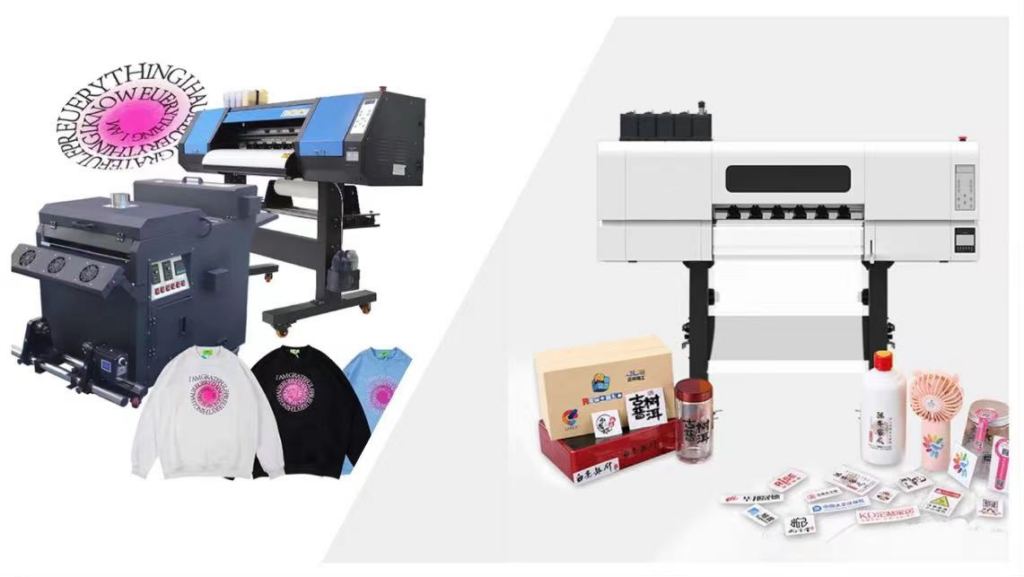
A. Vergleich der Druckqualität
Auflösung und Schärfe
Sowohl beim UV-DTF- als auch beim DTF-Druck können hochauflösende Drucke mit scharfen Details erzielt werden. Jedoch, Der UV-DTF-Druck kann aufgrund des UV-Härtungsprozesses zu etwas schärferen Ergebnissen führen, was die Tintenbeständigkeit erhöht.
Farbgenauigkeit und Lebendigkeit
Der UV-DTF-Druck bietet im Allgemeinen einen größeren Farbraum, Dies ermöglicht eine genauere Farbwiedergabe und lebendige Designs. DTF-Druck, während es zu lebendigen Farben fähig ist, Es kann zu Einschränkungen bei der Erzielung bestimmter Schattierungen und Töne kommen.
B. Arten von Substraten
Stoffoptionen
Sowohl der UV-DTF- als auch der DTF-Druck können zum Bedrucken verschiedener Stoffarten verwendet werden, einschließlich Baumwolle, Polyester, und Mischungen. Jedoch, Beim DTF-Druck sind bei bestimmten Stoffen möglicherweise zusätzliche Schritte oder eine Vorbehandlung erforderlich, um eine optimale Tintenhaftung zu gewährleisten.
Drucken auf harten Oberflächen
Wenn es um das Drucken auf harten Oberflächen wie Glas geht, Plastik, oder Keramik, UV-DTF-Druck ist die bevorzugte Wahl. Der UV-Härtungsprozess gewährleistet eine hervorragende Tintenhaftung und Haltbarkeit auf diesen Oberflächen.
C. Produktionsgeschwindigkeit und Effizienz
Der UV-DTF-Druck bietet im Vergleich zum DTF-Druck schnellere Produktionszeiten. Die sofortige Trocknung von UV-DTF-Tinten macht längere Trocknungszeiten überflüssig, was einen effizienteren Arbeitsablauf ermöglicht.
D. Kostenvergleich
Der UV-DTF-Druck ist im Allgemeinen mit höheren Vorlaufkosten verbunden, da spezielle UV-Tinten und -Geräte erforderlich sind. DTF-Druck, andererseits, bietet einen kostengünstigeren Einstiegspunkt für Neulinge
Druckunternehmen.
E. Wartungs- und Instandhaltungsanforderungen
Sowohl UV-DTF- als auch DTF-Druckgeräte erfordern regelmäßige Wartung und Instandhaltung. Jedoch, UV-DTF-Drucker müssen aufgrund der Beschaffenheit von UV-Tinten möglicherweise häufiger gereinigt und ausgetauscht werden.
DTF vs. UV-DTF, Welches ist besser?
| Typ | DTF-Druck | UV-DTF-Druck |
| Technologie | Druckt auf eine Folie, die dann durch Hitze auf das Material gepresst wird. | Kombiniert DTF-Technologie mit UV-Licht, um die Tinte sofort auszuhärten. |
| Tinte | Verwendet CMYK+ weiße Tinte, gedruckt auf einer transparenten PET-Folie. | Verwendet UV-Tinte, gedruckt auf einer transparenten PET-Folie. |
| Anwendung | Baumwolle, Polyester, Baumwoll-Poly-Mischungen, Leder, Nylon, und mehr. | Baumwolle, Polyester, Baumwoll-Poly-Mischungen, Leder, Nylon, Plastik, Holz, Metall, und sogar Glas, und mehr. |
| Detail | Sehr hohe Bildqualität und Detailtreue. | Hohe Bildqualität und Detailtreue, obwohl der UV-Prozess es leicht beeinflussen kann. |
| Haltbarkeit | Sehr langlebig, hält aber möglicherweise nicht so lange wie UV-DTF. | Sehr langlebig, Der UV-Prozess verlängert die Haltbarkeit des Drucks. |
Vergleichstabelle zwischen DTF und UV DTF
Wann sollte man sich für den UV-DTF-Druck entscheiden?
Der UV-DTF-Druck ist eine geeignete Wahl für Unternehmen oder Privatpersonen, die hochwertige Drucke mit lebendigen Farben und scharfen Details suchen. Es ist ideal für diejenigen, die Wert auf schnellere Produktionszeiten legen, Sie müssen auf harten Oberflächen drucken, und kann die anfänglichen höheren Kosten ausgleichen.
Wann Sie sich für den DTF-Druck entscheiden sollten
Der DTF-Druck ist eine kostengünstige Option für Einsteiger in die Druckindustrie. Es bietet Vielseitigkeit hinsichtlich der kompatiblen Untergründe und ist relativ einfach zu verwenden und zu pflegen. Der DTF-Druck wird denjenigen empfohlen, die Wert auf Kosteneffizienz legen, Vielseitigkeit bei Druckmaterialien, und Einfachheit in der Bedienung.
Auswahl der richtigen Druckmethode

Gewünschte Druckqualität
Berücksichtigen Sie die Bildschärfe, Farbgenauigkeit, und Lebendigkeit, die Sie für Ihre Drucke benötigen. Der UV-DTF-Druck zeichnet sich in diesen Bereichen aus, während der DTF-Druck eine kostengünstigere Option mit respektabler Druckqualität bietet.
Art der zu bedruckenden Materialien
Berücksichtigen Sie die Vielfalt der Substrate, auf denen Sie drucken möchten. Wenn Sie davon ausgehen, dass Sie auf harten Oberflächen oder Materialien drucken müssen, die möglicherweise eine Vorbehandlung erfordern, UV-DTF-Druck ist die bessere Wahl.
Produktionsmengen und Fristen
Wenn Sie strenge Produktionsfristen oder hohe Druckanforderungen haben, Die schnelle Produktionszeit des UV-DTF-Drucks ist möglicherweise besser geeignet. Jedoch, wenn Produktionsmengen nicht im Vordergrund stehen, Der DTF-Druck bietet eine leistungsfähige Alternative.
Verfügbares Budget
Berücksichtigen Sie Ihr verfügbares Budget für die Ausrüstung, Tinten, und Wartung. Der UV-DTF-Druck erfordert im Allgemeinen eine höhere Vorabinvestition, während der DTF-Druck einen kostengünstigeren Einstiegspunkt darstellt. Sowie, Es ist wichtig, eine zu wählen zuverlässiger Hersteller von Stoffdruckern.
Abschluss
Abschließend, UV-DTF-Druck und DTF-Druck sind zwei unterschiedliche Methoden, die eine außergewöhnliche Bildqualität und Vielseitigkeit bieten.
Der UV-DTF-Druck zeichnet sich durch lebendige Farben aus, scharfe Details, und die Möglichkeit, auf verschiedenen Substraten zu drucken, Dies macht es ideal für Unternehmen mit höheren Budgetzuweisungen und spezifischen Druckanforderungen. DTF-Druck, andererseits, bietet einen kostengünstigen Einstiegspunkt für kleine Unternehmen und Einzelpersonen, die Vielseitigkeit suchen, Einfachheit, und Benutzerfreundlichkeit.
Letzten Endes, Die Wahl zwischen UV-DTF-Druck und DTF-Druck hängt von Faktoren wie den Druckanforderungen ab, Substratvielfalt, Produktionsmengen, und verfügbarem Budget. Indem Sie diese Faktoren berücksichtigen und die Stärken und Grenzen jeder Methode verstehen, Sie können eine fundierte Entscheidung treffen und hervorragende Druckergebnisse erzielen.

